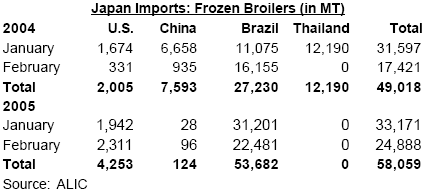



International Egg and Poultry Review
By the USDA's Agricultural Marketing Service - This is a weekly report looking at international developments concerning the poultry industry, this week looking at Animal Welfare Standards in the EU.
European Union Animal Welfare Standards
In May, 2005 the European Commission adopted a proposal for
legislation covering the protection of chickens kept for meat production
(broilers). The proposed legislation will be the first EU legislation
specifically for broilers. Directive 98/58/EC lays down the minimum
standards for the protection of animals bred or kept for farming purposes,
however the standards are very general and loosely defined. The EU
already has Directive 99/74EC, which sets minimum standards for the
protection of laying hens.
The proposal set a basic maximum stocking density of 30 kg live animals
per square meter (m2) and a number of conditions addressing
appropriate access to litter, drinkers and feed, as well as proper
ventilation, temperature and humidity. Member states may provide that
chickens be kept at a stocking density not exceeding 38 kg/m2 in
establishments, or single units of an establishment, if the owner or
keeper complies with the requirements set out in Annex II, in addition to
the requirements set out in Annex I.
Annex I Requirements Applicable to all Establishments.
Annex I requires, among other things, that feed be continuously available and not withdrawn from chickens more than 12 hours before slaughter time; chickens have permanent access to easily crumbled, dry litter; sound levels are minimized; light follows a 24-hour rhythm including periods of darkness lasting at least 8 hours in total; inspections conducted twice daily; detailed record keeping. Establishments with less than 100 chickens, with breeding stocks of chickens, and hatcheries are excluded from these requirements.
Annex II Requirements For the Use of Higher Stocking Densities.
Annex II details the notification and documentation required for stocking
density over 30 and up to 38 kg/m2. Each establishment must maintain
and have available in the establishment a compiled documentation
describing in detail the production systems. The ventilation, heating and
cooling systems must not allow the concentration of NH3 (ammonia) to
exceed 20 ppm and CO2 (carbon dioxide) to exceed 3000 ppm; the
inside temperature, when the outside temperature measured in the shade
exceeds 30 degrees Celsius (86 degrees Fahrenheit), cannot exceed
the outside temperature by more than 3 degrees Celsius; and when the
outside temperature is below 10 degrees C, (50 degrees F) the relative
humidity inside the unit cannot exceed 70%.
Proposals have to be approved by the European Parliament and national
governments before they can become law. Animal welfare groups argued
the rules didn’t address the genetic aspects of broiler chicken production.
Five billion birds are slaughtered every year in the EU. Stocking densities
in most Member States are currently 40-42 kg/m2. Producers fear that
the increased costs for meeting these new requirements will aggravate
the EU broiler sector’s competitive disadvantage with Brazil and Thailand.
Source: Official Journal of the European Communities, EUROPA Rapid
Press Releases, UK Department of Agriculture and Rural Development

Animal Welfare Chapters, OIE Terrestrial Animal Health Code
The International Committee of the World Organization for Animal
Health (OIE) held its 73rd Annual General Session from May 22- 27,
2005. Delegates of the OIE voted to adopt global standards for the
transport and slaughter of live animals.
Standards on animal welfare, included in 4 chapters, were adopted
(i.e. slaughter for human consumption, including religious slaughter;
land and sea transport of animals; humane killing of animals for
disease control purposes). This is the first time an organization
with a global mandate provides the international community with
standards in this field. The adopted chapters went into effect at the
conclusion of the 73rd General Session on May 27, 2005.
Although the OIE standards are a voluntary code they are important
in that they provide a basis for the development of new or improved
animal welfare laws.
Source: OIE Press Release, UK Department for Environment, Food
and Rural Affairs Press Release, EU Midday Express
To view the full report, including tables please click here
Source: USDA's Agricultural Marketing Service - 21st June 2005








